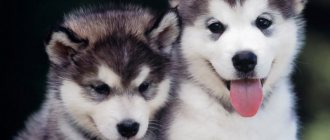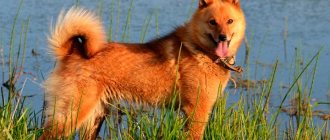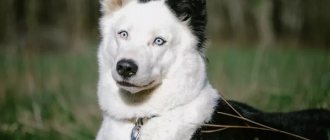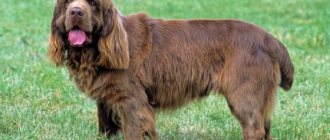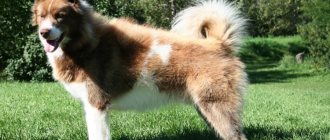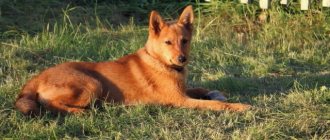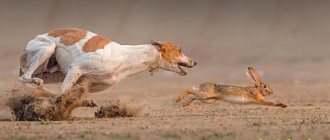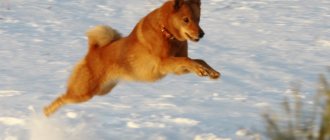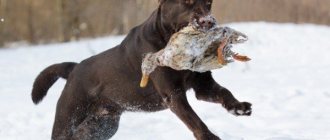Origin story
The East Siberian Laika is a representative of northern Russian dogs. The first mentions date back to the mid-19th century. At that time, immigrants from the European part of Russian lands went to develop Siberian and Far Eastern territories. The goal of breeding is a perfect working dog, capable of hunting large animals.
You can come across the name Evenki Laika or Evenki. There is no description of it in the specialized literature, but it is believed that the East Siberian Laika is a subtype of the Evenk Laika.
What is the difference between the East Siberian Laika and the West Siberian Laika?
For many ignorant people in this matter, the main guideline is the color, by which it is easiest to recognize the breed.
The East Siberian Laika is characterized by a black and tan or solid black color, while the West Siberian Laika standard considers this color to be a serious fault. At the same time, in both breed groups there are representatives of red and brown colors, how can they be distinguished from each other? “Easterners” are somewhat larger and more powerful in constitution, have a coarser body and muzzle structure, and a stretched body compared to “Westerners.” The breeds also differ in the shape of the ears: for “Easterns” slightly rounded ends are acceptable, for Westerners they are always only sharp, for “Easterns” they are set at eye level, and for “Westerners” they are set higher. You can also find a number of other breed differences, but only real experts can notice them. Fans of these breeds also note that East Siberian Laikas have a more trusting look, while their Western counterparts have a more lively and cunning look.
If we talk about character, then Western Siberian Laikas by nature are more striving for leadership, including over a person, which was not noticed among the Easterners.
Nansen Fridtjof, a Norwegian explorer, purchased 26 East Siberian Laikas for his Arctic expedition in 1893-1896.
Owner reviews of the East Siberian Laika
Michael:
These are natural hunters, universal dogs, they work on any animal - even a pheasant, even a bear! They are not afraid of anything. But I am against such dogs living in an apartment - they are free animals who love to work.
Nikolay:
This is a dog that is characterized by independence and perseverance. She will go without hesitation even towards a bear. Easy to learn. Puppies are expensive, but they are worth it - my husband is a hunter, I know what I’m saying.
Lera:
No matter what they say, VSL lives in our apartment and feels great. Her husband goes hunting with her and always returns with prey. The dog gets along well with children and is very smart - he never even pulls on the leash outside.
The East Siberian Laika is a very interesting and mysterious breed, and I would like you to share with us your experience of communicating with these dogs: how they get along at home, how best to train them to the beast, what diseases these dogs are susceptible to and what is the best way to feed them. Write your questions and answers in the comments under the article.
Share
Leave a review
Add a comment Cancel reply
- Anastasia
VSL ended up in my one-room apartment by accident: volunteers at a bus stop picked up a box with 6 puppies a year ago, I decided to foster one, but it never worked out to give him away. But I don’t regret staying with us. Other dog breeders said that it was a husky when they saw the puppy. Then I thought it was just a mongrel. I started looking at it myself and it turned out to be a real husky. It matches what is written in the article. We are lucky that we live in the suburbs and have a park where we can walk our dogs. And in this time there is also doing. We missed out on professional training due to inexperience, so there are problems with socialization and communication with other dogs. We are already deciding on the fly. You have to put up with the “alert” about strangers: it barks when the neighbors come home. Really very smart, easy to train dog. But also willful due to lack of proper upbringing from childhood. I am constantly working on not losing my authority. In general, the apartment is not a problem for us, because... We walk a lot. And because We don’t go hunting, we focus on intellectual stress: we constantly teach some new tricks, etc., to keep him occupied... By the way, he lives with a cat, the cat is older and appeared in the house earlier, and won’t let him down. Doesn't drive her too hard. If he tries, he gets a paw in the face) The cat can calm him down even faster than I can) And sometimes they run around together and play. They can “call” each other for this. But more at a distance. My younger sister is fine. She is 12. He perceives her as an equal, as a play partner. The main conclusion: you need to take a professional course in puppyhood with this breed, this is one hundred percent. It will make life easier for both the dogs, the owner, and those around him...
Character and behavior
Despite its northern origin, the animal easily adapts to other conditions and can work in almost any climate. The dog has a keen sense of smell, excellent eyesight and an innate hunter instinct. The character of the East Siberian Laika is distinguished by its independence: it is able to objectively assess current events and make the right decisions without the owner’s command.
On a note. The East Siberian Laika can hunt squirrel, sable, deer, elk, lynx and bear. Endurance and maneuverability allow the animal to be used as a sled dog.
East Siberian Laikas get along well with children, making them excellent family friends. They exhibit a hunting instinct towards other domestic animals. In rare cases, pets who grew up together find a common language.
Usage
Most AFLs have innate hunting qualities. Thanks to this, they begin to work independently; skillfully delivered coaching contributes to the development of the desired talents. The Eastern European Laika uses smell, hearing and sight in its work. The found animal barks. He follows the trail in silence. Different dogs exhibit the instinct to grab, strangle and eat prey to varying degrees. When hunting large animals, it is useful, but in the case of furs it leads to damage to the prey. Unlike other huskies, the VSL typically searches at a trot, and at times the dog moves to a walk or gallop. Works independently, without constant guidance and control of the hunter. She is smart, has a well-developed sense of smell, an approximate reaction, and monitors the owner’s movements. Constantly calling the dog reduces work efficiency. Can work on birds and even fetch from the water.
In the traditional habitats of East Siberian huskies, more than 30 species of animals and birds are hunted. The most important species are squirrel, sable, fox, muskrat, bear, and seal.
In some areas, hunters also use huskies to transport their equipment and prey. Those who live along the banks of rivers often train their dogs to work in a harness while the boat is sailing against the current. At the same time, the husky avoids, and sometimes even swims around, obstacles so as not to tangle the line. On the eastern and northern coasts of Lake Baikal, dogs are used in households to transport water and firewood. According to hunters, this adversely affects working qualities, so really good working dogs are not harnessed.
Interesting Facts
The East Siberian Laika breed developed in isolation, so very little is known about it.
However, there are still several interesting points associated with these animals:
- Scientists believe that all northern huskies descended from one ancestor - the fossil dog Inostrantsev. The remains of the animal were discovered in 1882 on the shores of Lake Ladoga.
- Polar explorer Nansen Fridtjof from Norway purchased dogs from Russia for the expedition of 1893–1896. It is believed that these were East Siberian huskies.
- After the collapse of the USSR, many nurseries of East Siberian huskies ceased to exist, which is why the animals were on the verge of extinction. Work is currently underway to restore the population.
Breed standard
The first description of the standard was compiled in 1949, and amendments were made in 1981. It has been preserved in this form and is in operation today.
The East Siberian Laika has the largest number of colors among its relatives approved by the FCI standard.
The table shows the main characteristics of the breed.
| Become | Description |
| Head | Wedge shaped. The skull is wide, the back of the head is rounded. Cheekbones are not clearly defined. |
| Muzzle | The size of the muzzle is equal to the length of the head. |
| Neck | Strong, muscular. |
| Ears | Triangular in shape, high standing, with dense cartilage. The inside is covered with soft fluffy wool. |
| Eyes | Almond shaped. Slant eyelid incision. The eyeball is neither bulging nor sunken. The iris is dark brown. |
| Nose | The nasal planum has rich black pigmentation. If the coat color is light, brown earlobes are acceptable. |
| Lips | Fit tightly. |
| Bite | Scissor-shaped, with a complete set of teeth. |
| Frame | The back is wide, powerful, muscular. The loin is short, slightly convex. The croup is wide and sloping. The chest is oval-shaped, wide. The abdomen is tucked in, the transition from the chest is weakly expressed. |
| Tail | Wrapped in a ring. The length of the tail should reach the hock joint. Covered with thick, coarse hair. |
| Limbs | Forequarters: slightly sloping, muscular, strong. Located parallel to each other. Rear: straight and parallel. Developed muscles. Clearly defined articulation angle when viewed from the side. |
| Paws | Oval shape. The fingers are pressed tightly against each other. |
| Wool | Consists of two layers: soft undercoat and hard guard hair. The head and limbs are covered with short hair. The neck, withers and shoulders have a longer coat and form a collar. |
| Movements | Working run: gallop or gait. |
Disadvantages, defects and disqualifying characteristics
Any deviation from the requirements of the standard is considered a defect. Its influence on the assessment of an individual is based on the severity of the defect and the dog’s ability to do the job.
The actual disadvantages include:
- insufficiently expressed sexual dimorphism;
- convex forehead, somewhat narrowed muzzle;
- partial depigmentation of the nose, lips and eyelids;
- lack of teeth - absence of no more than 4 premolars (from PM1 and PM2 in any combination);
- straight bite after 6 years;
- small, sparse teeth;
- light or amber eye color in black dogs;
- ears - large, low-set, soft, not sufficiently grown inside;
- the back is weak (soft), slightly humped;
- paws turned inward or outward (marked), clubfoot;
- flat or loose paws (not in a ball), insufficiently developed hair between the toes;
- dewclaws on the hind legs;
- slightly constrained movements;
- specks to match the main color on the body or head (on the paws are allowed).
The defects of the breed include:
- anger towards people;
- significant obesity or thinness;
- short or narrow muzzle;
- a strongly smoothed or pronounced transition from the forehead to the muzzle;
- absence of more than 4 premolars, including PM1 and PM;
- round, bulging eyes;
- the ears are excessively large with round tops and a wide base;
- square format;
- excessively extended format;
- light frame;
- heavy, unstable movements or ambling;
- wrinkled, loose skin;
- significantly elongated hair on the back of the front legs, pronounced dewlap on the hind legs and tail;
- wavy, curly, soft or too long coat;
- the specks on the body do not match the main color;
- deviation from standard height by more than 2 cm.
The reasons for disqualification of an individual are:
- aggressiveness or cowardice;
- malocclusion;
- misalignment of the jaws;
- 4 or more missing teeth, including PM1 and PM2 or M3, extra incisors;
- clouding of the cornea, eye color interspersed with a different color;
- hanging, semi-erect ears;
- short tail;
- short-haired or long-haired;
- lack of undercoat;
- color: genetic brown;
- genetic blue;
- brindle;
- albinism.
Description
Ordinary hunters call the East Siberian Laika one of the most valuable among all hunting breeds, and indeed all types of huskies.
The breed, which has been formed for hundreds of years, has a combination of excellent character, high endurance and strength. It is not surprising that you can often hear reviews of dogs of this breed as universal hunters.
Appearance
Large, fit and well-built - this is what a husky looks like. The dog's chest is quite voluminous, and the skeletal structure is strong with developed muscles. The East Siberian Laika differs from the European Laika in its much larger size, both in height and width. So the height of males can range from 55 to 64 cm, and that of females - 51 to 62 cm. Animals weigh from 18 to 23 kg.
The shape of the muzzle resembles a wedge, which is slightly shorter than the wide skull of the dog. The husky has very strong teeth and a scissor bite. The dog's eyes are slanted and oval, the predominant color is brown of various shades. On the top of the head you can always see erect triangular ears, the tips of which stand out - unlike their Western counterparts, East Siberian huskies are more rounded, and their ears themselves are set no higher than eye level.
The dog is covered with a long and thick layer of fur throughout its body. On the ears and head the layer of fur is smaller and more shiny. And at the level of the chest and at the withers, a more voluminous layer stands out, which is especially pronounced in males. The husky's tail is curled into a ring, which usually either lies on the hip or is raised above the back.
The acceptable coat color for the Eastern Siberian husky is gray, white-black, brown, black-piebald or just black. White, fawn or red colors are considered a fault.
Character and habits
Laikas have a versatile character, given that they have a desire to hunt in their blood. On the one hand, there is calmness and equanimity, which manifest themselves in everyday life: they lack aggression towards people. They are often quite tolerant of strangers while they are on their territory, however, after leaving it, they can show distrust of strangers. Therefore, East Siberian huskies are not entirely suitable for home guarding only.
On the other hand, the East Siberian Laika is distinguished by high endurance and activity, therefore, when getting such a pet in the city, you need to be prepared for long and exhausting walks in the park. This can be a plus if the animal lives in a large family - they love children very much and active games will not let anyone get bored.
However, if we talk about the number of family members, it is worth noting that hunting huskies can recognize only one person as their owner; she will consider the rest as at least equal to herself. And then, you need to not miss the moment when the dog is looking for its place in the house, because it will not cost anything for it to take a dominant position in the family. Also, it is better not to get a husky if there is already another animal in the house - friendship will only work with active preparation and work with the dog.
Application
Laikas were bred as hunting helpers and for use as sled dogs.
Unlike its relatives, the West Siberian Laika and the Karelian Bear Laika, the Eastern Laika matures late. The dog is ready for a full hunt when it is closer to two years of age. Going out hunting with a husky is a pleasure for both the owner and the pet. The peculiarity of this breed is its selective pursuit of prey.
Training and education of the East Siberian Laika
Laikas are easy to train due to their sharp mind and understanding - even a novice dog breeder can handle them , but training the animal should be done by an experienced hunter. The VSL also needs early socialization and communication with other dogs.
Remember that huskies are prone to dominance , so let the dog know who is boss in the house, but without cruelty - with a husky, like with any other dog, it is best to train using the “positive reinforcement” technique.
Hunting
The East Siberian Laika is a born hunter. Since ancient times it has been used for hunting various game and fur-bearing animals, especially sable. Thanks to their developed body and large size, huskies can help in catching larger animals: bear, wild boar, moose and even lynx.
Purpose and character of the East Siberian Laika
The East Siberian Laika is a born hunter , which is used by hunters to hunt both fur-bearing animals (sable), game, and large wild animals (bear, ungulates, lynx). In the northern regions of Russia, you can often find VSLs working in harness - their strength and endurance allow huskies to safely transport loads .
The East Siberian Laika can be used as a watchman, but this “profession” is not a specialized one for a dog, especially since it is quite difficult for this freedom-loving animal to live on a leash.
The East Siberian Laika is not aggressive and is not known for its malice toward humans . She gets along well with her owner and his family members. The dog is distrustful of strangers and notifies its owners of the approach of a stranger with a loud bark.
The working husky is a relatively calm and balanced dog that can be not only a hunter, but also an excellent companion. In the absence of physical activity and work, such a dog can become hyperactive .
VSL has a good instinct and hunting passion, because of which he can abandon his owner during a walk and run away, following the trail of an animal. Therefore, the husky does not get along well with other animals - the hunting instinct is “to blame.” It gets along well with other dogs if it has undergone socialization in time or has grown up with them.
Features of maintenance and care
The East Siberian Laika is a freedom-loving and physically active animal. Living freely in the city is not possible. The special constitution of the body requires an active lifestyle, so the best place for it is the countryside. The dog is kept on a leash. An irrepressible hunting passion drives the dog in search of adventure. A husky that finds itself free can attack neighboring animals and birds.
Grooming
Caring for a husky's fur is not difficult. Does not require frequent bathing. Periodically, you can wipe the wool with a cloth moistened with a weak aqueous solution of vinegar. During the period of seasonal molting, the dog actively loses hair. Frequent brushing will help speed up this process.
Dental care includes weekly examinations for the presence of tartar. If necessary, soft plaque is removed using a damp gauze swab.
The claws of working huskies do not require grooming or trimming; they wear down naturally. Dogs living in urban areas have their nails trimmed as they grow.
Walk
Oriental huskies require long walks. If there is not enough walks, the dog may begin to damage property and destroy the apartment. Therefore, keeping in rural areas, with a large local area, will be an ideal place for keeping.
Feeding
Laika is an unpretentious dog. She accepts dry food well. But experienced hunters believe that this breed needs only natural food.
East Siberian husky puppies are sent to new owners at the age of about one and a half to two months. By this time, he can already take food such as oatmeal cooked in meat and bone broth.
After 2 months, puppies can be given natural food. Salted and smoked foods are prohibited. To strengthen bones, add half a teaspoon of finely crushed egg shells to your food daily. At this age, the puppy begins to receive finely chopped raw meat.
It is necessary to teach your dog to eat raw vegetables and fruits: beets, carrots, tomatoes, apples. They are necessary for normal digestion and also contribute to the natural cleaning of teeth. To strengthen its teeth, the East Siberian husky is regularly given large raw bones and tendons to chew on.
At 2 months of age, the number of feedings is 5-6 times a day. By 8-10 months of age, the dog is fed twice a day, the diet is the same as that of an adult. Many breeders note that Siberian huskies regulate the amount of food they eat.
A working dog that regularly goes hunting has a better appetite than a city apartment pet. The greater the energy expenditure, the more the dog requires food.
The table shows a list of recommended and prohibited products.
| Allowed | Prohibited |
| Lean meat (raw and boiled) | Pickles |
| Lean fish (boiled) | Spicy dishes |
| Fermented milk products (up to six months) | Tubular bird bones |
| Vegetables and fruits | Smoked products |
| Cereals | Sweet pastries |
| Vegetable oil | |
| Eggs |
What to feed the East Siberian Laika
Laika is an unpretentious dog and not prone to food allergies. It is enough to feed an adult dog 2 times a day. The serving size depends on the amount of physical activity. It is also worth remembering that working huskies are fed according to the following scheme : in the morning they are given 1/3 of the daily portion of food, and after the hunt - the remaining 2/3.
Puppies are fed depending on age from 3 to 6 times a day. The diet of both a baby and an adult dog should include meat, fish, vegetables, and grains. Note that during the active growth of puppies (2-6 months) and during the change of teeth, they need to add calcium to their food.
Mating
Laiki is a breed of dog that has not been modified as a result of human selection. The reproductive function is preserved at the level of its ancestors - wild predators such as wolves, jackals: they are ready to mate once a year.
With the appearance of the first objective signs of estrus, the bitch is isolated from the males, preventing escape and accidental mating. At the same time, it is necessary to carry out measures to expel worms and treat the dog for fleas and ticks. Giving your dog anti-parasitic drugs after breeding can cause premature birth or deformed puppies.
On days 11-12 after the start of estrus, you can begin the process. But it’s better to observe the dog’s behavior. The main sign of a bitch’s readiness is that when stroking the rump, the dog stands calmly and moves its tail to the side. The second way to check is to let the dog down. If the bitch lets you sit, it means she is ready. At the same time, both huskies are kept on their leashes.
The meeting for the “newlyweds” is arranged in the morning, after a good walk. The bitch is brought into the dog's territory. East Siberian huskies mate on an empty stomach. Males usually breed on their own; sometimes you have to hold the bitch, especially if this is her first mating. If she is too aggressive and tries to bite the dog, then she is muzzled.
Where can I buy an East Siberian Laika?
In order not to end up with a mixed breed, but to purchase a purebred breed, you need to use the services of proven nurseries with a good reputation.
The price of an East Siberian Laika depends on the achievements of the puppy's parents. If they are able to drive down a large animal, then their puppies are usually more expensive.
A potential buyer is recommended to prepare at least twenty thousand rubles; prices for mestizos are more affordable and can fluctuate in the amount of five thousand rubles.
How to choose an East Siberian husky puppy
Choosing an East Siberian husky puppy should start with choosing its parents . Decide what you want to get from your dog. If you are an avid hunter, then you need to look for a litter born from two working dogs.
For exhibitions, you can purchase a puppy with good external characteristics, but we note that in this case it is better for you to take a teenage puppy, when it is already clear whether he will be promising at exhibitions. In general, it is possible to take a baby away from its mother and bring it to a new home at the age of 1.5-2 months.
It is also important to decide on the gender of the future puppy - males can be used for hunting all year round, but females can only be used when they are not in heat.
Price
The price of an East Siberian husky puppy varies greatly depending on geography, the merits of the parents and many other factors. In nurseries, puppies usually cost 25,000-35,000 rubles. For private breeders, 5,000-15,000 rubles. An adult working husky can cost 60,000 rubles. and more expensive.
How much do East Siberian Laika puppies cost?
The average price for an eastern husky puppy is 20-25 thousand rubles. When searching through private advertisements or at bird markets, you can find a pet cheaper. But no one will give any guarantee regarding the purity of the breed.
Nurseries
To purchase an East Siberian husky puppy, it is better to contact nurseries. Only here you can find a guaranteed purebred puppy with excellent working qualities. Experienced breeders will tell you everything about the pros and cons of the breed, and help with advice and recommendations. After all, the husky is a hunting breed. Puppies inherit all their best qualities from their parents. By buying a puppy from an unknown breeder, you can get not just an ordinary mongrel, but a dog that is not at all intended for hunting. The main breed nurseries are located in Siberia and the Far East. In the central part of Russia you can contact the Laiki nursery. It is located in Pushkino, Moscow region. (www.laiki-pitomnik.ru).
Siberian huskies are freedom-loving animals. They need active physical activity. Hunting is the best way to realize natural instincts.
Health of Siberian Laikas
East Siberian Laika puppies have been in fairly good health since their birth and almost never encounter genetic diseases. These characteristics are suitable for a standard healthy dog. As for the most common diseases, these are mostly viruses and bacteria, which can be quite easily prevented by timely vaccination of the animal. It is also worth noting that the husky must be vaccinated against the rabies virus. This is due to the fact that an animal can quite easily become infected with it during the hunt, from a sick animal. Thus, if you are going to use your pet for hunting purposes, then it is worth vaccinating it, starting from puppyhood.
In general, a dog’s life expectancy is approximately fourteen years, but in order for the pet to live this period and feel well enough, it is necessary to monitor its health and promptly visit the veterinarian for timely vaccinations and preventive examinations. Physical activity should also be feasible and not mixed with the feeding process in order to preserve the health of your pet’s stomach as much as possible.
Vaccinations and susceptibility to disease
Timely vaccination is an essential part of caring for any animal. East Siberian Laika puppies are vaccinated at 8–9 weeks from:
- carnivore plague;
- parvovirus enteritis;
- leptospirosis;
- viral hepatitis;
- parainfluenza.
After 3-4 weeks, the puppy is vaccinated again with the addition of a rabies vaccine. Adults are revaccinated annually and treated against worms and blood-sucking parasites every 3 months.
The animals are hardened by the harsh conditions of Siberia, so they do not suffer from hereditary diseases. While hunting, a dog can catch distemper or rabies, but vaccinations protect against these diseases. If the owner takes proper care of the pet, the East Siberian Laika will live 12–15 years.
Brief characteristics of the East Siberian Laika breed
- Other possible names for the dog: VSL, Easten-Sibirian Laika.
- The height of an adult dog: the height of a male at the withers ranges from 57 to 70 cm, of a female - from 53 to 65 cm.
- Weight: approximately 20-23 kg, some individuals reach 35-40 kg.
- Characteristic color: caramel (black and tan), black and white, black or white, zoned, red, gray, fawn, spotted, with the exception of bright red, brindle color. The nose is black; a brown nose is considered a fault.
- Coat length: VSL's coat is straight, hard, with a thick undercoat, allowing the dog to easily endure the harsh Siberian frosts. On the neck the fur forms a rich collar. The hair on the paws and muzzle is short and coarse.
- Lifespan: about 12-15 years.
- Advantages of the breed: they are distinguished by excellent health, endurance, are not aggressive towards humans, but are very vigilant and can be not only hunters, but also excellent watchdogs.
- Difficulties of the breed: not suitable for keeping in an apartment and needs a lot of physical activity.
- Average price: without a pedigree, but with good working qualities, you can buy an East Siberian Laika puppy for $130, and with a pedigree - twice as expensive, about $260.
